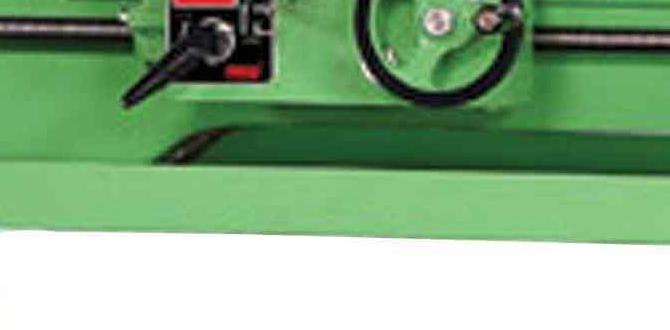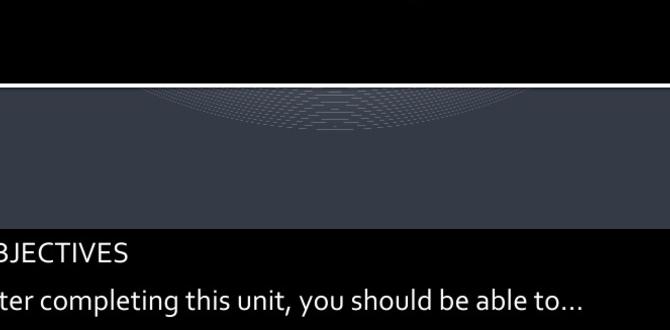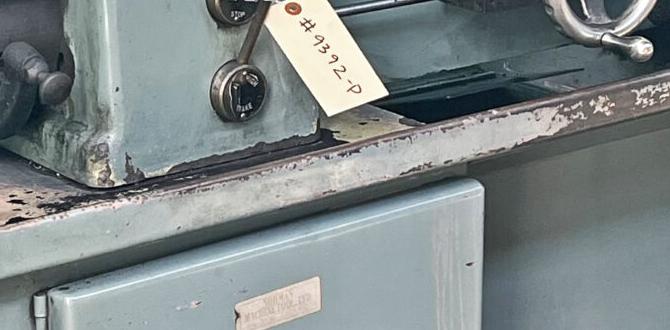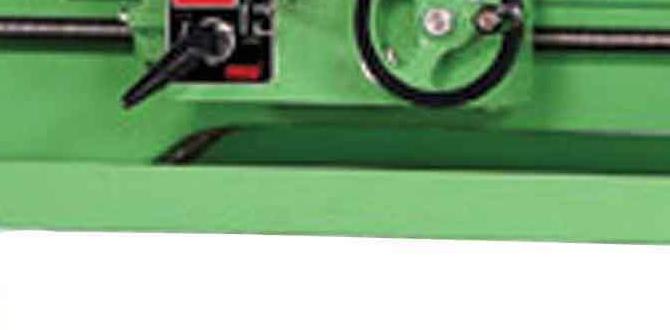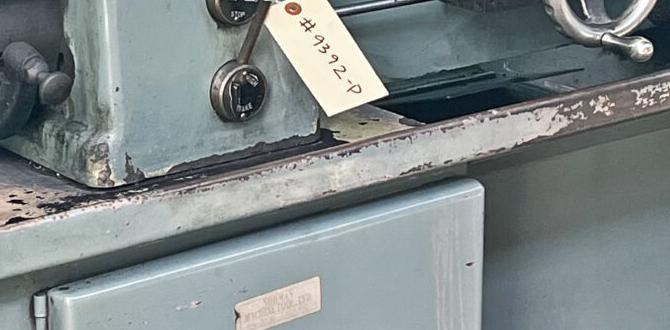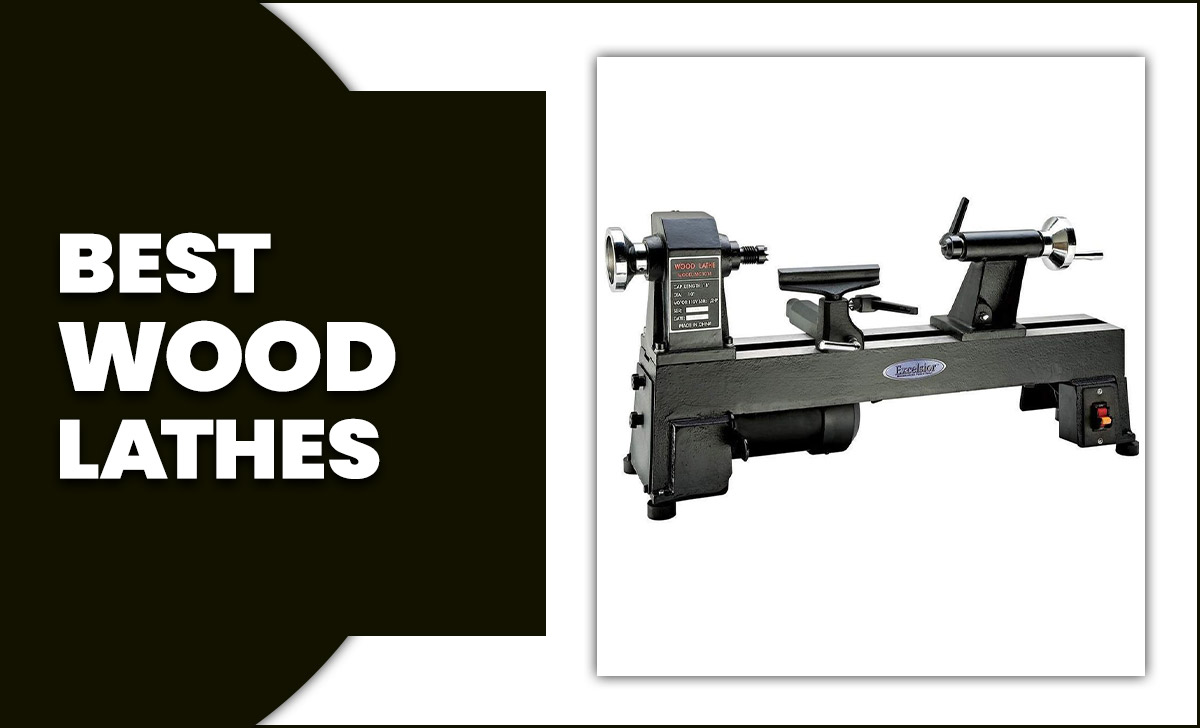A wood lathe variable frequency drive (VFD) is a fantastic upgrade for any woodturner. It provides smooth, precise speed control, making your lathe safer and more versatile. Instantly adjust your speed for different wood types and turning tasks, giving you better control and cleaner cuts. This guide breaks down what a VFD is and why it’s a game-changer for your workshop.
Hey folks, Daniel Bates here from Lathe Hub! Ever found yourself wishing your wood lathe had a bit more finesse when it comes to speed? Maybe you’re wrestling with a tough piece of hardwood, or perhaps trying to achieve a silky-smooth finish on soft pine. That moment when the speed just isn’t quite right, and you wish you could just reach over and dial it in perfectly, is common for many woodturners.
Well, I’ve got some great news! There’s a piece of technology that can transform your wood lathe experience: the Variable Frequency Drive, or VFD. Think of it as the ultimate speed control system for your lathe. No more fiddling with belt changes that take ages and often leave you with a speed that’s still not quite right. A VFD gives you precise, on-the-fly adjustments, opening up a whole new world of possibilities for your turning projects.
If you’ve been feeling limited by your lathe’s existing speed settings, or you’re just curious about how to get more out of your machine, you’re in the right place. We’re going to dive deep into what a VFD is, explore its amazing benefits, and figure out how it can make your woodworking projects safer, more enjoyable, and frankly, a whole lot better. Let’s get your lathe running smarter!
What is a Wood Lathe Variable Frequency Drive (VFD)?
At its core, a Variable Frequency Drive (VFD) is an electronic device that controls the speed of an AC motor. For our wood lathes, it’s usually designed to take the standard household power (like 120V or 240V) and cleverly adjust its frequency and voltage to tell the lathe’s motor how fast to spin. It’s like having a dimmer switch for your motor, but much more sophisticated!
Most wood lathes come with either a multi-speed pulley system or a basic electronic speed control. While these might work for simple tasks, they often lack the fine-tuning needed for optimal results. The pulley system requires you to stop the lathe, open it up, move belts, and restart – a real hassle! Basic electronic controls can sometimes feel a bit jumpy or don’t offer a wide enough range, especially at the lower end.
A VFD, on the other hand, allows for continuous, smooth speed adjustments, often from a very low speed all the way up to the motor’s maximum. This means you can find that “sweet spot” for any type of wood or turning operation literally at your fingertips. It’s not just about speed; it’s about having complete command over your machine.
How Does a VFD Work on a Wood Lathe?
Let’s break down the magic without getting too deep into complex engineering. Your standard AC motor in the lathe runs on a fixed frequency, usually 60 Hz in North America. This frequency, along with the motor’s design, determines its maximum speed. The VFD intervenes in this process.
1. Rectification: The VFD first takes the incoming AC power and converts it into DC (Direct Current) power. Think of this as smoothing out the electrical current.
2. Inversion: Then, it takes that DC power and cleverly converts it back into AC power, but this time, it can control the frequency of that AC power. Lower frequency means the motor spins slower; higher frequency means it spins faster.
3. Motor Control: By adjusting the output frequency (and often the voltage along with it, in a controlled way), the VFD dictates the rotational speed of the motor. Most VFDs also have controls for acceleration and deceleration ramps, meaning the speed changes smoothly rather than instantly, which is much kinder to your motor and workpiece.
This continuous control is the key. Instead of distinct “steps” of speed, you get a dial or buttons that let you dial in the exact RPM (Revolutions Per Minute) you need. This is crucial for everything from rough turning large blanks to intricate detail work and polishing.
The Genius Benefits of a Wood Lathe VFD
Upgrading to a VFD isn’t just a minor tweak; it’s a significant leap forward in lathe performance and usability. The benefits are substantial, improving safety, efficiency, and the quality of your work. Let’s look at the top advantages:
1. Unparalleled Speed Control
This is the most obvious and impactful benefit. A VFD offers a virtually infinite range of speeds. This is invaluable because different woods require different speeds:
- Large, unbalanced blanks: You’ll want a low starting speed to prevent vibration and potential accidents.
- Hardwoods: Often benefit from slightly higher speeds for efficient cutting.
- Softwoods: Can be turned at a wide range of speeds, but lower speeds are better for dust control and preventing tear-out.
- Finishing and sanding: Lower, consistent speeds are ideal for achieving a super-smooth surface without burning or creating ridges.
With a VFD, you can adapt instantly to any situation, achieving better cuts, cleaner finishes, and a more enjoyable turning experience. You can often set a specific RPM target, and the VFD will hold it, even if the load on the motor changes.
2. Enhanced Safety
Woodturning can be dangerous if proper precautions aren’t taken, and speed is a major factor. A VFD greatly enhances safety in several ways:
- Controlled Starting: You can set a very slow ramp-up speed. This minimizes the risk of a workpiece flying off the lathe when you first start it, especially if it’s slightly unbalanced.
- Emergency Stops: Many VFDs allow for quick “stop” commands, bringing the motor to a halt much faster than simply turning off the power.
- Precise Control for Delicate Work: For intricate details or working with fragile materials, having precise low-speed control is essential for avoiding mistakes and damage.
- Reduced Vibration: Finding the optimal speed can significantly reduce dangerous vibrations, keeping the lathe and workpiece stable.
Working at safe speeds is paramount, and a VFD gives you the confidence to do just that.
3. Smoother Operation and Better Finishes
The controlled acceleration and deceleration provided by a VFD protect your motor and drive train. Instead of the abrupt start and stop of a direct-on motor or pulley system, the VFD gently ramps the motor up and down. This:
- Reduces Mechanical Stress: Less wear and tear on bearings, belts, and motor components.
- Prevents Spline Stripping: A common issue when starting motors abruptly.
- Improves Cut Quality: Consistent, controlled speed leads to cleaner cuts and less tear-out, especially in figured or difficult-to-turn woods.
- Easier Sanding and Finishing: You can select the perfect low speed for sanding and applying finishes, leading to professional-looking results without burning or chatter marks.
4. Increased Power and Torque at Low Speeds
A significant advantage of many VFDs is their ability to provide full torque even at very low RPMs. Traditional lathes often lose a lot of their power and torque when you switch to their slowest pulley settings. This means:
- Turning Large Blanks: You can start turning large, heavy, or unbalanced pieces at very low speeds without the motor bogging down.
- Hollowing Bowls: The motor will have the strength to handle the increased load when hollowing the inside of bowls.
- Better Control under Load: The lathe will feel more robust and responsive when you’re taking significant cuts.
This improved low-speed torque is a game-changer for many turning tasks.
5. Energy Efficiency
While not the primary reason for most users, VFDs can offer energy savings. By only using the power needed to maintain the desired speed and torque, they can be more efficient than running a motor at full speed and then trying to control it through other means. This is especially true if you find yourself frequently working at lower speeds.
6. Versatility and Upgradability
A VFD can often breathe new life into older lathes that might not have had the most advanced speed control from the factory. It allows you to “upgrade” a lathe’s capabilities significantly, moving it closer to the performance you’d expect from a much more expensive, modern machine.
Types of VFDs for Wood Lathes
When you’re looking to add a VFD to your wood lathe, you’ll encounter a few common types and configurations. The best choice for you will depend on your lathe’s motor and your budget.
1. Standalone VFD Units
These are self-contained units that you wire between your lathe’s power source and its motor. They typically come with a control panel that can be mounted remotely (e.g., on the lathe bed or a stand) for easy access. You’ll need to ensure the VFD is rated for your motor’s horsepower and voltage.
- Pros: Offers the most flexibility, wide range of models available, can be a good solution for DIY conversions.
- Cons: Requires electrical wiring knowledge, component selection can be daunting for beginners, may need a custom enclosure.
2. Integrated Variable Speed Lathes
Many modern wood lathes come equipped with VFD technology built-in from the factory. These units are designed to work seamlessly with the lathe’s motor and controls. You’ll often see a digital display showing the current RPM, and the speed is adjusted with a dial or buttons.
- Pros: Plug-and-play simplicity, professionally integrated, designed for the specific motor.
- Cons: Typically found on more expensive lathes, not an upgrade option for existing simpler models.
3. Retrofit Kits
Some manufacturers and third-party suppliers offer VFD retrofit kits specifically designed for certain popular wood lathe models. These kits typically include the VFD unit, a suitable enclosure, often a new control panel, and sometimes even a new motor or mounting hardware. They aim to simplify the installation process.
- Pros: Easier installation than standalone units, components are matched, often come with instructions.
- Cons: Can be more expensive than sourcing components yourself, limited to specific lathe models.
Choosing the Right VFD
Regardless of the type, consider these factors:
- Horsepower (HP): Match the VFD’s HP rating to your lathe motor’s HP. It’s often recommended to get a VFD rated slightly higher than your motor for better reliability.
- Voltage: Ensure the VFD can accept your incoming voltage (e.g., 120V or 240V) and output the correct voltage for your motor.
- Phase: Most home workshop equipment uses single-phase power, so ensure the VFD is designed for single-phase input and output for your motor. Some VFDs can take single-phase input and provide a pseudo-three-phase output to the motor, which can improve performance.
- Control Interface: How will you adjust the speed? A simple dial, buttons, or a digital display all offer different levels of usability. Remote mounting is a big plus.
- Brand Reputation: Stick with reputable brands known for quality and customer support.
Installation Considerations: Simple Steps for a DIY Upgrade
Adding a VFD to a non-VFD lathe is a rewarding project, but it does require some basic electrical knowledge and care. The exact steps will vary depending on the VFD unit and your lathe, but here’s a general overview of what you might do. If you are not comfortable with electrical wiring, it is highly recommended to consult with a qualified electrician or purchase a retrofit kit with clear instructions. Safety first!
Here’s a simplified breakdown:
Step 1: Gather Your Tools and Components
You’ll need the VFD unit, appropriate gauge wire, connectors, a way to mount the VFD and its control panel (often a small metal enclosure or even directly to the lathe), wire strippers, screwdrivers, and possibly a drill to mount components. Always have your lathe’s manual and the VFD manual handy.
Step 2: Disconnect Power!
This is the most critical step. Ensure the lathe is completely disconnected from its power source. Unplug it. Double-check that no power can reach the motor circuit.
Step 3: Understanding Your Lathe’s Motor Wiring
Locate your lathe’s motor and its electrical connection points. You’ll need to identify the wires that go from the power source to the motor. This usually involves accessing a junction box or the motor’s terminal block.
Step 4: Wiring the VFD Input
The VFD has input terminals for connecting to your main power source (Line, L1, L2, or equivalent). You will disconnect the wires coming from your wall plug or breaker and connect them to these input terminals on the VFD. Pay close attention to correct voltage and phasing (L1, L2 for 240V, or L1, N for 120V).
Step 5: Wiring the VFD Output to the Motor
The VFD also has output terminals (U, V, W, or T1, T2, T3) that connect to the motor. You will disconnect the wires that used to go directly from power to the motor and instead connect them to these output terminals on the VFD. Note that for a standard motor, you might need to swap two wires if the motor runs backward.
Step 6: Mounting the Control Panel
Most VFDs come with a separate control panel or potentiometer (speed knob) that you’ll want to mount somewhere easily accessible on your lathe. This usually involves running a cable from the VFD to the control panel. Follow the VFD manufacturer’s specific instructions for this.
Step 7: Configuration and Testing
Now, power up the VFD (with the lathe motor still connected). You’ll need to configure the VFD’s parameters. This is a crucial step and often the most complex. You’ll need to tell the VFD about your motor (HP, RPM, frequency) and set up basic functions like acceleration/deceleration times. Consult your VFD manual extensively here. Many VFDs have default settings that can get you started, but proper programming ensures optimal performance and motor longevity.
A common parameter to adjust is “Motor Rotation” or “Phase Sequence”. If your motor spins the wrong way, you’ll typically swap any two of the (U, V, W) output wires connected to the motor.
Start with a slow speed setting and gradually increase it, listening for any unusual noises and checking the motor’s temperature if possible. Make small cuts to test performance.
For a more detailed guide, you might find resources on specific lathe model VFD conversions online. For instance, some enthusiasts have documented adding VFDs to popular brands like Powermatic, Grizzly, or Delta lathes.
Pros and Cons of Adding a VFD
Every upgrade has its trade-offs. While a VFD offers significant advantages, it’s good to be aware of the downsides before you commit. Here’s a balanced look:
Pros:
- Superior Speed Control: Infinite, precise RPM adjustment for any task.
- Enhanced Safety: Gradual starts, controlled stops, better workpiece stability.
- Improved Performance: Smoother operation, cleaner cuts, better finishes.
- Low-Speed Torque: Handles large blanks and demanding cuts with ease.
- Reduced Wear: Less stress on motor and components due to soft starts/stops.
- Increased Versatility: Makes an older lathe feel modern and capable.
- Potential Energy Savings: More efficient use of power at lower speeds.
Cons:
- Installation Complexity: Requires electrical knowledge, can be intimidating for beginners.
- Cost: VFD units and kits can be a significant investment.
- Potential for Motor Overheating: If not properly configured, poor ventilation, or wrong settings, the motor can overheat, especially at very low speeds where cooling from fan might be reduced.
- Electromagnetic Interference (EMI): VFDs generate some electrical noise that can interfere with other sensitive electronics in the workshop, though this is usually manageable with proper shielding and grounding.
- Learning Curve: Understanding VFD parameters and configuration takes time and effort.
- Motor Compatibility: While most AC motors work, some specialized motors might have compatibility issues.
Choosing the Right Wood for Your Lathe Projects
Once you have a V


